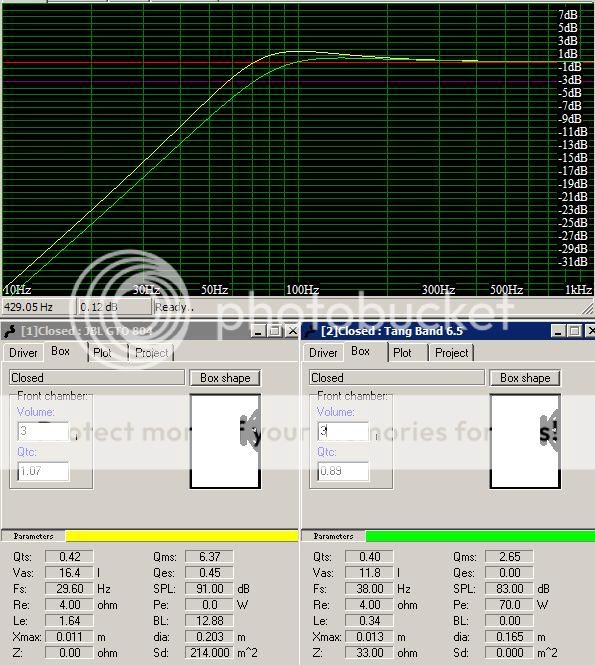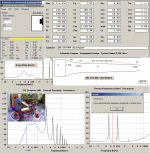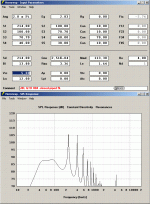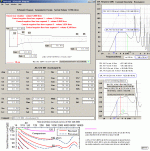Hi, these are great forums, I've checked them out many times, first time posting...
Yes, I'm considering putting sound in my bike. Yes its unusual, and it has its limitations, but I'm exploring the possibility nonetheless.

I've considered installing headphone drivers in my helmet but I'd rather go for sound on my bike for safety (being able to hear), to enjoy the bass, and to be able to chill with friends near the bike and enjoy the music.
I think the music should be enjoyable while driving through traffic, driving around town, and stopped at traffic lights, but I have to somehow test this theory because my exhaust is pretty loud.
I've already tested listening to music in my room wearing my helmet. It kills the high frequencies but the music is still very enjoyable. I tried EQing down the bass and while still fairly enjoyable, I don't think its worth it unless I can get bass
Under the passenger seat, with the woofer facing the ground, theres enough space for possibly even a 12" sub.
10" subs are cheap and quite common so I played a bit with winISD to see what response a 3L enclosure would provide.

But then I checked out these little drivers
http://tb-speaker.com/detail/1230_04/w6-1139si.htm
Affordable, NdFe and small.
I highly prefer them from a weight perspective, and they are probably better designed for a small enclosure.
The electrical system produces 350W at 12-15V, not sure how much is available.
Assuming I could do the subwoofer, I'd install 4" mids and tweeters next to the front forks in the fairing pointing up at my head.
A preamp could be added to correct the poor response curve, so the response curve doesn't matter as long as there is a decent amount of it
Has anyone tried a ridiculously small enclosure before?
Yes, I'm considering putting sound in my bike. Yes its unusual, and it has its limitations, but I'm exploring the possibility nonetheless.

I've considered installing headphone drivers in my helmet but I'd rather go for sound on my bike for safety (being able to hear), to enjoy the bass, and to be able to chill with friends near the bike and enjoy the music.
I think the music should be enjoyable while driving through traffic, driving around town, and stopped at traffic lights, but I have to somehow test this theory because my exhaust is pretty loud.
I've already tested listening to music in my room wearing my helmet. It kills the high frequencies but the music is still very enjoyable. I tried EQing down the bass and while still fairly enjoyable, I don't think its worth it unless I can get bass
Under the passenger seat, with the woofer facing the ground, theres enough space for possibly even a 12" sub.
10" subs are cheap and quite common so I played a bit with winISD to see what response a 3L enclosure would provide.

But then I checked out these little drivers
http://tb-speaker.com/detail/1230_04/w6-1139si.htm
Affordable, NdFe and small.
I highly prefer them from a weight perspective, and they are probably better designed for a small enclosure.
The electrical system produces 350W at 12-15V, not sure how much is available.
Assuming I could do the subwoofer, I'd install 4" mids and tweeters next to the front forks in the fairing pointing up at my head.
A preamp could be added to correct the poor response curve, so the response curve doesn't matter as long as there is a decent amount of it
Has anyone tried a ridiculously small enclosure before?
What other software would you recommend I try besides winISD?
once I have my dB curve in winISD, how do I determine what SPL I can get at a specific frequency with different amounts of power?
I did this in excel, is it correct?
assuming sensitivity 82 dB and 0dB enclosure amplification
1 W 83 dB
2 W 86 dB
4 W 89 dB
8 W 92 dB
16 W 95 dB
32 W 98 dB
64 W 101 dB
128 W 104 dB
256 W 107 dB
so at 40hz, with -11dB enclosure amplification at 64W I'll be getting 90dB? and @ 50hz 94dB?
I don't have a good sense of how much power that is perceptually.
once I have my dB curve in winISD, how do I determine what SPL I can get at a specific frequency with different amounts of power?
I did this in excel, is it correct?
assuming sensitivity 82 dB and 0dB enclosure amplification
1 W 83 dB
2 W 86 dB
4 W 89 dB
8 W 92 dB
16 W 95 dB
32 W 98 dB
64 W 101 dB
128 W 104 dB
256 W 107 dB
so at 40hz, with -11dB enclosure amplification at 64W I'll be getting 90dB? and @ 50hz 94dB?
I don't have a good sense of how much power that is perceptually.
yeah, I figured that already  i'd put a fine mesh grill and possibly some very thin open weave fabric over the sub, being under the seat and facing down and covered it could be untreated paper.
i'd put a fine mesh grill and possibly some very thin open weave fabric over the sub, being under the seat and facing down and covered it could be untreated paper.
for the mids I read people usually lacker the cones. without 'noticing' much difference in sound quality. i might just give them one or 2 thin black coats of spray paint.
i'd probably also make some flexible black plastic covers with elastic which I could just slip over them when they're not in use.
i'd probably point the tweeters downwards and make drip guides for them
for the mids I read people usually lacker the cones. without 'noticing' much difference in sound quality. i might just give them one or 2 thin black coats of spray paint.
i'd probably also make some flexible black plastic covers with elastic which I could just slip over them when they're not in use.
i'd probably point the tweeters downwards and make drip guides for them
This is interesting, I've just come across the JBL GTO 804, and so far its the first larger sub which actually outperforms the tang band in a small enclosure. The enclosure amplification is about 2dB more for the JBL.
Added with the massive 91dB sensitivity, vs the Tang Band's 83dB sensitivity, its a whopping 8dB advantage going with the JBL, almost double the percieved loudness.
The JBL costs a bit more, but is much easier for me to get, so they could be considered the same cost.
The only downside to the JBL: weight. It weighs 4.7kg vs the Tang Band's 1.7kg. 3kg extra. But since I'm adding weight anyway, who gives a crap

Added with the massive 91dB sensitivity, vs the Tang Band's 83dB sensitivity, its a whopping 8dB advantage going with the JBL, almost double the percieved loudness.
The JBL costs a bit more, but is much easier for me to get, so they could be considered the same cost.
The only downside to the JBL: weight. It weighs 4.7kg vs the Tang Band's 1.7kg. 3kg extra. But since I'm adding weight anyway, who gives a crap

Just above where your frequency curves are, there's a series of tabs. One says SPL. Click that and mess around with power input to see what drivers are capable of.
You may want to use winISD pro to get max spl because that takes Xmax into account, and winISD beta doesn't.
The JBL driver looks good. Have you tried other 8" drivers?
Chris
PS - get a dB meter - this will help your project a lot. If you make a nice response curve etc, it might all go to waste if you don't know how loud the exhaust is.
You may want to use winISD pro to get max spl because that takes Xmax into account, and winISD beta doesn't.
The JBL driver looks good. Have you tried other 8" drivers?
Chris
PS - get a dB meter - this will help your project a lot. If you make a nice response curve etc, it might all go to waste if you don't know how loud the exhaust is.
speaker power
I wanted to get a sense for how loud x amount of power is.
For the test I used a bass note of 48hz on my celestion F15s (whos rated response only starts at 65hz) in my room.
Its not the best test by any means, but since I had no idea how loud x amount of power is I figured its better than nothing
I turned it up on the amp to a level where I feel is the minimum bass capability a system should have to be enjoyable. Using a True RMS multimeter (Meterman 37XR) I measured 1.2V AC across the speaker, and 0.130A AC through the speaker. they're 8 ohm.
this is only 0.156W. Can this be accurate? Seems like a lot of bass for a tiny amount of power!
But now that I think about it, this amp is only 30W RMS! (Marantz PM4000) and I've pumped it extremely loud before. (previously on some B&Ws with 10" subs)
Its funny becuase when I think of bass, i think of my 12" kenwood I used to have in my car, with the 2 cuft ported box, and the 180W RMS I used to drive it with, but that was kind of ridiculous
Is there a calculation to see how many dB a room adds compared to open space?
I wanted to get a sense for how loud x amount of power is.
For the test I used a bass note of 48hz on my celestion F15s (whos rated response only starts at 65hz) in my room.
Its not the best test by any means, but since I had no idea how loud x amount of power is I figured its better than nothing
I turned it up on the amp to a level where I feel is the minimum bass capability a system should have to be enjoyable. Using a True RMS multimeter (Meterman 37XR) I measured 1.2V AC across the speaker, and 0.130A AC through the speaker. they're 8 ohm.
this is only 0.156W. Can this be accurate? Seems like a lot of bass for a tiny amount of power!
But now that I think about it, this amp is only 30W RMS! (Marantz PM4000) and I've pumped it extremely loud before. (previously on some B&Ws with 10" subs)
Its funny becuase when I think of bass, i think of my 12" kenwood I used to have in my car, with the 2 cuft ported box, and the 180W RMS I used to drive it with, but that was kind of ridiculous
Is there a calculation to see how many dB a room adds compared to open space?
It's all room dependant. Positioning, room size, to a lesser extent, room location (could be the basement etc).
You have to remember that it's a lotharithmic scale with power to decibels. 2x power = +3dB.
Which means it can be difficult to get really high spls because of the huge amp power needed.
When measuring the power, you seem to have forgotten Ohm's law:
V=IR, where V = voltage
I = amps
R = resistance.
So, using this, you were putting in around 1W of power.
Chris
You have to remember that it's a lotharithmic scale with power to decibels. 2x power = +3dB.
Which means it can be difficult to get really high spls because of the huge amp power needed.
When measuring the power, you seem to have forgotten Ohm's law:
V=IR, where V = voltage
I = amps
R = resistance.
So, using this, you were putting in around 1W of power.
Chris
Chris: on the contrary V=I*R is not an equation for power. P=V*I is an equation for power. 1.2V*0.13A = 0.156W
P=I^2*R is another equation for power. 0.13^2*8=0.1352 where 8 is the approximate impedence of the speaker (depends on frequency)
Bjorno: looks interesting, what program are you using there?
3L is the worst case scenario. I should be able to get a few litres above that.
P=I^2*R is another equation for power. 0.13^2*8=0.1352 where 8 is the approximate impedence of the speaker (depends on frequency)
Bjorno: looks interesting, what program are you using there?
3L is the worst case scenario. I should be able to get a few litres above that.
Bjorno: looks interesting, what program are you using there?
http://mywebsite.bigpond.com/dmcbean/
5L ? See the picture, now the f-3dB is about 40 Hz.
b
1(1)
Attachments
Hi all,
I wonder if a typical SPL attenuation measurement curve is aviable when using a bike helmet, thus if a loudspeaker is placed behind the head at a known distance and measured with a RTA or a integrating sound level meter?
b
Adding one more picture with lots of possible design numbers referring to my earlier suggestion:
1(1)
I wonder if a typical SPL attenuation measurement curve is aviable when using a bike helmet, thus if a loudspeaker is placed behind the head at a known distance and measured with a RTA or a integrating sound level meter?
b
Adding one more picture with lots of possible design numbers referring to my earlier suggestion:
1(1)
Attachments
- Status
- This old topic is closed. If you want to reopen this topic, contact a moderator using the "Report Post" button.
- Home
- Loudspeakers
- Subwoofers
- Subwoofer in a Motorcycle Passenger Seat (CONCEPT)



